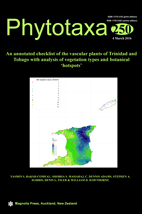Abstract
Although the publication of the vascular flora of the Caribbean islands of Trinidad and Tobago extended from 1928–1992, it is incomplete with the family Poaceae still outstanding. Many of the early recorded families are in need of extensive revision. Therefore, this checklist is intended to fill these gaps by providing a comprehensive list of the vascular plants for the islands. We compiled the checklist using the results from herbarium records, literature citations, online resources and a Rapid Botanic Survey (RBS) of 240 sample plots across the islands. From the RBS plots 22,500 vascular plant specimens were collected, yielding 1530 species. The herbarium records, literature citations and the RBS plots yielded a total of 3639 species, of which 2407 are indigenous, 1222 are exotic and 108 are endemic or near endemic. The low endemism is attributed to the islands’ close proximity to and recent separation from the South American continent. A total of 262 species of grasses (Poaceae) is published here for the first time along with the results from the RBS plots. Our annotated checklist further presents two types of conservation rating: the International Union for the Conservation of Nature Red List Categories and a global Star rating system. Based on the clustering of the ‘Star rating’ of each species, plant communities in the following areas: the Heights of Aripo, parts of the Nariva Swamp and the North-west Islands were identified as ‘hot spots’ of high conservation value which should continue to, or receive greater protection in the National Parks and Protected Areas system established in Trinidad and Tobago.

